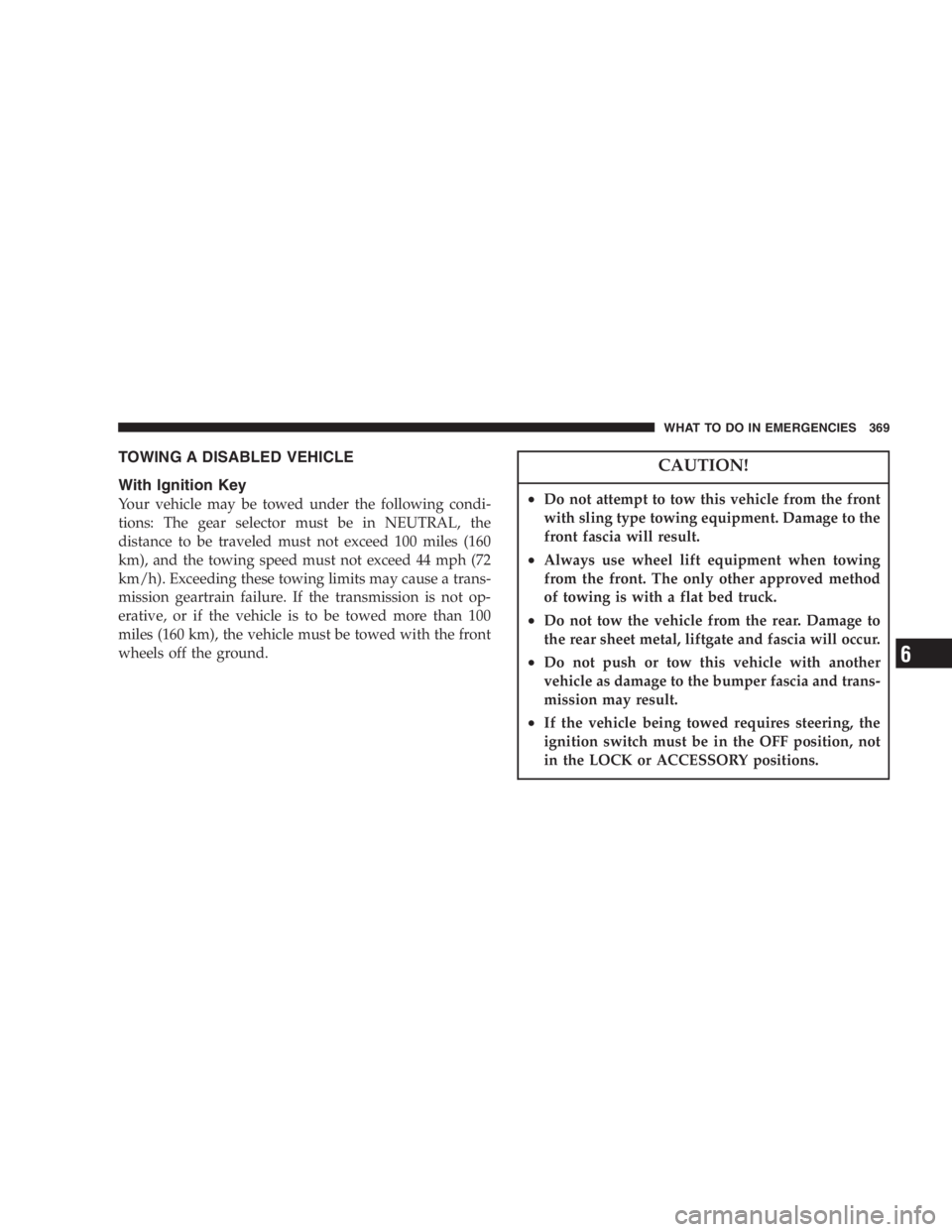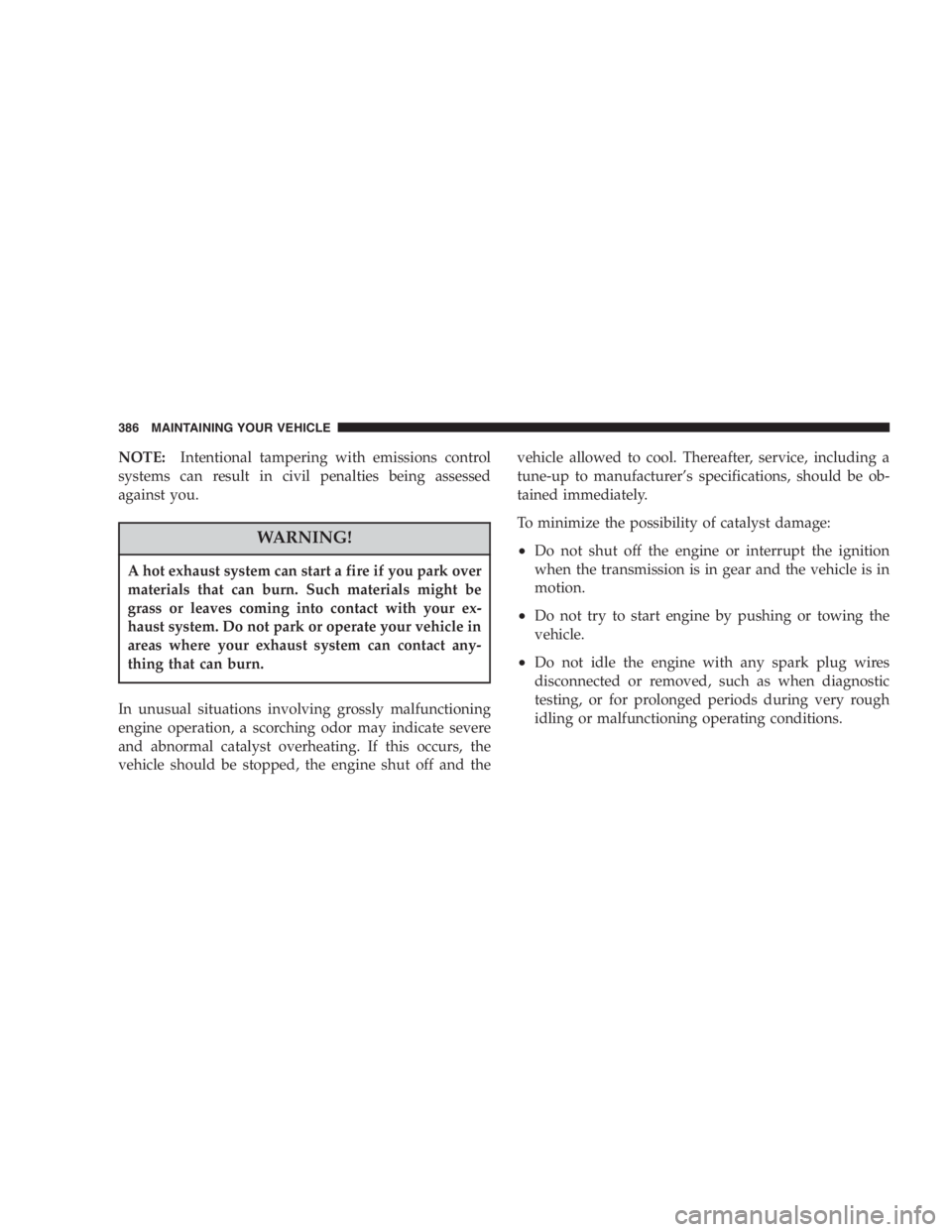Page 364 of 480

NOTE: Do not install the wheel cover on the compact
spare.
Do not use a hammer or force to install the wheel covers.
9. Lower the vehicle by turning the jack screw to the left.
10. Finish tightening the lug nuts. Push down on the
wrench while tightening for increased leverage. Alternate
lug nuts until each nut has been tightened twice. Correct
wheel nut tightness is 130 N · m (95 ft. lbs). If in doubt
about the correct tightness, have them checked with a
torque wrench by your dealer or at a service station.
11. Lower the jack to its fully closed position. WARNING!A loose tire or jack, thrown forward in a collision or
hard stop could endanger the occupants of the ve-
hicle. Always stow the jack parts and the spare tire in
the places provided.
12. Secure the flat or spare tire as follows:
• If your vehicle is equipped with cast aluminum
wheels, the center cap of the wheel must be re-
moved prior to flat tire stowage. Store the center cap
inside the glove box or other storage compartment.
• Turn the wheel so that the valve stem is down. Slide
the wheel retainer through the center of the wheel
and position it properly across the wheel opening.364 WHAT TO DO IN EMERGENCIES
Page 365 of 480
• For convenience in checking the spare tire inflation,
stow with the valve stem toward the rear of the
vehicle.
• Using the jack handle, rotate the drive nut to the
right until the wheel is drawn into place against the
underside of the vehicle.
• Continue to rotate the nut until you hear the mecha-
nism click three times. It cannot be overtightened.
Push against the tire several times to be sure it is
securely in place.
13. Stow the jack and jack handle.
14. Check the tire pressure as soon as possible. Correct
pressure as required. JUMP-STARTING PROCEDURES IF BATTERY IS
LOW
WARNING!Take care to avoid the radiator cooling fan whenever
the hood is raised. It can start anytime the ignition
switch is on. You can be hurt by the fan. WHAT TO DO IN EMERGENCIES 365
6
Page 366 of 480

WARNING!• Do not attempt to push or tow your vehicle to get it
started. Vehicles equipped with an automatic transmis-
sion cannot be started this way. Unburned fuel could
enter the catalytic converter and once the engine has
started, ignite and damage the converter and vehicle. If
the vehicle has a discharged battery, booster cables may
be used to obtain a start from another vehicle. This type
of start can be dangerous if done improperly, so follow
this procedure carefully.
• Battery fluid is a corrosive acid solution; do not allow
battery fluid to contact eyes, skin or clothing. Don ’ t lean
over battery when attaching clamps or allow the clamps
to touch each other. If acid splashes in eyes or on skin,
flush contaminated area immediately with large quan-
tities of water.
• A battery generates hydrogen gas which is flammable
and explosive. Keep flame or spark away from the vent
holes. Do not use a booster battery or any other booster
source with an output that exceeds 12 volts. 1. Wear eye protection and remove any metal jewelry
such as watch bands or bracelets that might make an
inadvertent electrical contact.
2. When boost is provided by a battery in another
vehicle, park that vehicle within booster cable reach and
without letting the vehicles touch. Set the parking brake,
place the automatic transmission in PARK and turn the
ignition switch to the OFF position for both vehicles.
3. Turn off the heater, radio and all unnecessary electrical
loads.
4. Connect one end of a jumper cable to the positive
terminal of the discharged battery. Connect the other end
of the same cable to the positive terminal of the booster
battery.366 WHAT TO DO IN EMERGENCIES
Page 369 of 480

TOWING A DISABLED VEHICLE
With Ignition Key
Your vehicle may be towed under the following condi-
tions: The gear selector must be in NEUTRAL, the
distance to be traveled must not exceed 100 miles (160
km), and the towing speed must not exceed 44 mph (72
km/h). Exceeding these towing limits may cause a trans-
mission geartrain failure. If the transmission is not op-
erative, or if the vehicle is to be towed more than 100
miles (160 km), the vehicle must be towed with the front
wheels off the ground. CAUTION!• Do not attempt to tow this vehicle from the front
with sling type towing equipment. Damage to the
front fascia will result.
• Always use wheel lift equipment when towing
from the front. The only other approved method
of towing is with a flat bed truck.
• Do not tow the vehicle from the rear. Damage to
the rear sheet metal, liftgate and fascia will occur.
• Do not push or tow this vehicle with another
vehicle as damage to the bumper fascia and trans-
mission may result.
• If the vehicle being towed requires steering, the
ignition switch must be in the OFF position, not
in the LOCK or ACCESSORY positions. WHAT TO DO IN EMERGENCIES 369
6
Page 370 of 480
If it is necessary to use the accessories while being towed
(wipers, defrosters, etc.), the key must be in the ON
position, not the ACCESSORY position. Make certain the
transmission remains in NEUTRAL.
Without The Ignition Key
Special care must be taken when the vehicle is towed
with the ignition in the LOCK position. The only ap-
proved method of towing with out the ignition key is
with a flat bed truck. Proper towing equipment is neces-
sary to prevent damage to the vehicle.
TOWING THIS VEHICLE BEHIND ANOTHER
VEHICLE (Flat towing with all four wheels on the
ground)
Flat towing of vehicles equipped with an automatic
transmission, is only permitted within the limitations
described in this section. TOWING THIS VEHICLE BEHIND ANOTHER
VEHICLE WITH A TOW DOLLEY
The manufacture does not recommend that you tow a
front wheel drive vehicle on a tow dolley. Vehicle damage
may occur.370 WHAT TO DO IN EMERGENCIES
Page 376 of 480

ONBOARD DIAGNOSTIC SYSTEM — OBD II
Your vehicle is equipped with a sophisticated onboard
diagnostic system called OBD II. This system monitors
the performance of the emissions, engine, and automatic
transmission control systems. When these systems are
operating properly, your vehicle will provide excellent
performance and fuel economy, as well as engine emis-
sions well within current government regulations.
If any of these systems require service, the OBD II system
will turn on the “ Malfunction Indicator Light. ” It will
also store diagnostic codes and other information to
assist your service technician in making repairs. Al-
though your vehicle will usually be drivable and not
need towing, see your dealer for service as soon as
possible. CAUTION!• Prolonged driving with the “ Malfunction Indica-
tor Light ” on could cause further damage to the
emission control system. It could also affect fuel
economy and driveability. The vehicle must be
serviced before any emissions tests can be per-
formed.
• If the “ Malfunction Indicator Light ” is flashing
while the engine is running, severe catalytic con-
verter damage and power loss will soon occur.
Immediate service is required.376 MAINTAINING YOUR VEHICLE
Page 381 of 480

Change Engine Oil
Road conditions and your kind of driving affects the
interval at which your oil should be changed. Check the
following list to see if any apply to you.
• Day or night temperatures are below 32 ° F(0 ° C).
• Stop and Go driving.
• Extensive engine idling.
• Driving in dusty conditions.
• Short trips of less than 10 miles (16 km).
• More than 50% of your driving is at sustained high
speeds during hot weather, above 90 ° F (32 ° C).
• Trailer towing.
• Taxi, Police or delivery service (commercial service).
• Off-Road or desert operation. If ANY of these apply to you, then change your engine oil
at every interval shown in schedule “ B ” of the “ Mainte-
nance Schedules ” section of this manual.
If none of these apply to you, then change your engine oil
at every interval shown on schedule “ A ” of the “ Main-
tenance Schedules ” section of this manual
NOTE: Under no circumstances should oil change in-
tervals exceed 6000 miles (10 000 km) or 6 months
whichever comes first.
Engine Oil Selection
For best performance and maximum protection under all
types of operating conditions, the manufacturer only
recommends engine oils that are API certified and meet
the requirements of DaimlerChrysler Material Standard
MS-6395. MAINTAINING YOUR VEHICLE 381
7
Page 386 of 480

NOTE: Intentional tampering with emissions control
systems can result in civil penalties being assessed
against you.
WARNING!A hot exhaust system can start a fire if you park over
materials that can burn. Such materials might be
grass or leaves coming into contact with your ex-
haust system. Do not park or operate your vehicle in
areas where your exhaust system can contact any-
thing that can burn.
In unusual situations involving grossly malfunctioning
engine operation, a scorching odor may indicate severe
and abnormal catalyst overheating. If this occurs, the
vehicle should be stopped, the engine shut off and the vehicle allowed to cool. Thereafter, service, including a
tune-up to manufacturer ’ s specifications, should be ob-
tained immediately.
To minimize the possibility of catalyst damage:
• Do not shut off the engine or interrupt the ignition
when the transmission is in gear and the vehicle is in
motion.
• Do not try to start engine by pushing or towing the
vehicle.
• Do not idle the engine with any spark plug wires
disconnected or removed, such as when diagnostic
testing, or for prolonged periods during very rough
idling or malfunctioning operating conditions.386 MAINTAINING YOUR VEHICLE